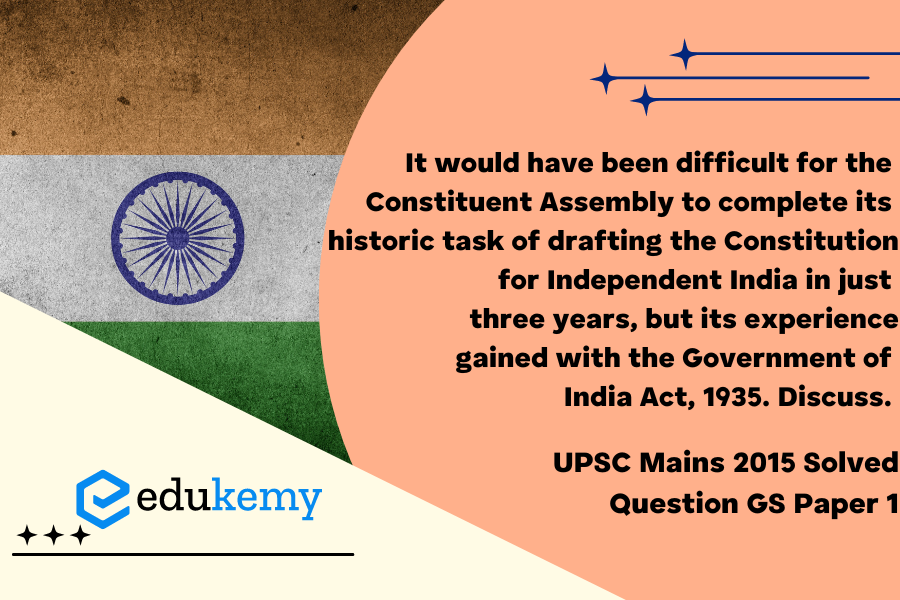The Constituent Assembly of India faced an arduous and historic challenge in drafting the Constitution for Independent India within a mere three years. However, this formidable task was made more manageable due to the invaluable experience gained through the Government of India Act, of 1935. The Government of India Act, of 1935, served as a crucial precursor, laying the groundwork for the constitutional framework and administrative machinery that would later shape the nation. The assembly benefited from the insights and lessons garnered during the implementation of this act, which provided a blueprint for governance and administration. The Act introduced several constitutional principles and administrative structures that proved instrumental in the subsequent drafting process. The experience gained in navigating the complexities of governance under the 1935 Act empowered the members of the Constituent Assembly with a nuanced understanding of India’s diverse socio-political landscape. This prior knowledge not only expedited the drafting process but also informed the assembly’s decisions, ensuring a more informed and contextualized approach to the creation of the Constitution. In essence, the Constituent Assembly’s journey was enriched by the preceding experience with the Government of India Act, of 1935, facilitating the timely and effective completion of its historic task of crafting the foundational document for the newly independent nation.
Tag: The Freedom Struggle.
Contents
Decoding the Question:
- The introduction starts with a meeting of the Constituent Assembly.
- In the Body, discuss features of the Indian Constitution taken from GOI 1935 & other sources.
- Conclude the answer with a suitable conclusion balancing GOI 1935 & other sources.
Answer:
The Constituent Assembly took almost three years to complete its historic task of drafting the Constitution for Independent India. During this period, it held eleven sessions covering a total of 165 days.

The Constitution was a by-product of the legacy started by the Government of India Act 1935. This was the longest act passed by the British government with 321 sections and 10 schedules. This act had drawn its content from four sources – The report of the Simon Commission, discussions and deliberations at the Third Round Table Conference, the White Paper of 1933, and the reports of the Joint Select Committees.
Some features of the Government of India Act 1935 that was adopted in the Constitution:
- Features of Federal Legislature and Provincial autonomy were taken from the Government of India Act, of 1935. The 1935 Act divided powers between the Centre and the Province which was better for the administration at ground level as well.
- Another feature that had been taken was provincial autonomy. This autonomy worked better for regulating the states or provinces without the interference of external authorities. Also, the states or the provinces knew their people’s condition better than any other external authority.
- A Federal Court that was established in 1937 through the Government of India Act, 1935 was considered as the Supreme Court by independent India.
- The Constitution of India also borrowed the feature that every state should have a Governor who would be elected by the Central Government.
- Public Service Commission that we see in Article 315 of the Indian Constitution had also been taken from the Government of India Act, 1935
The Government of India Act 1935 gave a solid foundation to work upon. It gave both the basic structural framework of the federal system and also administrative detail and eased the work of the constituent assembly to a greater extent. However the Govt of India Act was created to manage the affairs of a colony upon vested commercial interests of Great Britain. The basic ideas of the Constitution were also laid down throughout the freedom struggle by freedom fighters.
In case you still have your doubts, contact us on 9811333901.
For UPSC Prelims Resources, Click here
For Daily Updates and Study Material:
Join our Telegram Channel – Edukemy for IAS
- 1. Learn through Videos – here
- 2. Be Exam Ready by Practicing Daily MCQs – here
- 3. Daily Newsletter – Get all your Current Affairs Covered – here
- 4. Mains Answer Writing Practice – here


